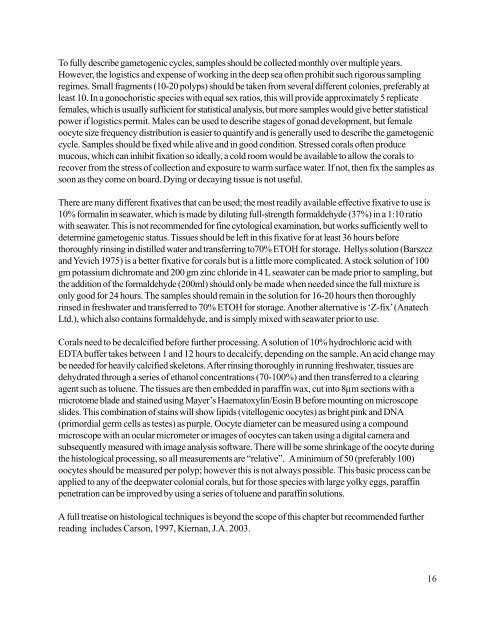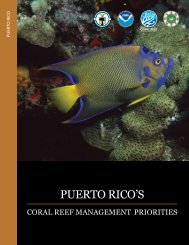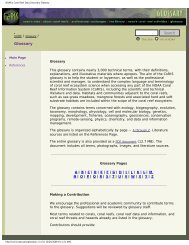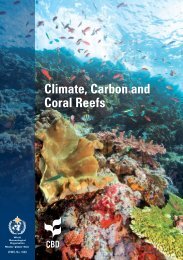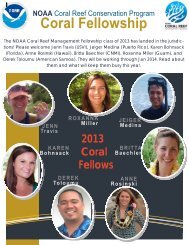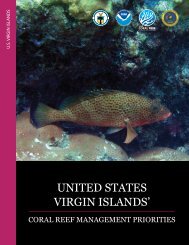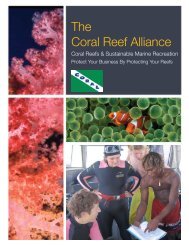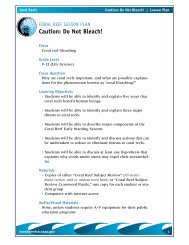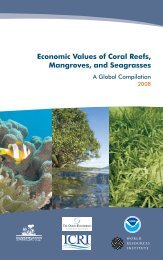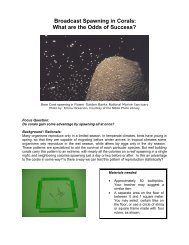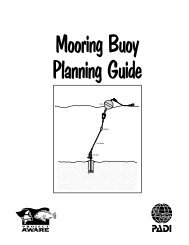Deep-Sea Coral Collection Protocols - NOAA's Coral Reef ...
Deep-Sea Coral Collection Protocols - NOAA's Coral Reef ...
Deep-Sea Coral Collection Protocols - NOAA's Coral Reef ...
- No tags were found...
Create successful ePaper yourself
Turn your PDF publications into a flip-book with our unique Google optimized e-Paper software.
To fully describe gametogenic cycles, samples should be collected monthly over multiple years.However, the logistics and expense of working in the deep sea often prohibit such rigorous samplingregimes. Small fragments (10-20 polyps) should be taken from several different colonies, preferably atleast 10. In a gonochoristic species with equal sex ratios, this will provide approximately 5 replicatefemales, which is usually sufficient for statistical analysis, but more samples would give better statisticalpower if logistics permit. Males can be used to describe stages of gonad development, but femaleoocyte size frequency distribution is easier to quantify and is generally used to describe the gametogeniccycle. Samples should be fixed while alive and in good condition. Stressed corals often producemucous, which can inhibit fixation so ideally, a cold room would be available to allow the corals torecover from the stress of collection and exposure to warm surface water. If not, then fix the samples assoon as they come on board. Dying or decaying tissue is not useful.There are many different fixatives that can be used; the most readily available effective fixative to use is10% formalin in seawater, which is made by diluting full-strength formaldehyde (37%) in a 1:10 ratiowith seawater. This is not recommended for fine cytological examination, but works sufficiently well todetermine gametogenic status. Tissues should be left in this fixative for at least 36 hours beforethoroughly rinsing in distilled water and transferring to70% ETOH for storage. Hellys solution (Barszczand Yevich 1975) is a better fixative for corals but is a little more complicated. A stock solution of 100gm potassium dichromate and 200 gm zinc chloride in 4 L seawater can be made prior to sampling, butthe addition of the formaldehyde (200ml) should only be made when needed since the full mixture isonly good for 24 hours. The samples should remain in the solution for 16-20 hours then thoroughlyrinsed in freshwater and transferred to 70% ETOH for storage. Another alternative is ‘Z-fix’ (AnatechLtd.), which also contains formaldehyde, and is simply mixed with seawater prior to use.<strong>Coral</strong>s need to be decalcified before further processing. A solution of 10% hydrochloric acid withEDTA buffer takes between 1 and 12 hours to decalcify, depending on the sample. An acid change maybe needed for heavily calcified skeletons. After rinsing thoroughly in running freshwater, tissues aredehydrated through a series of ethanol concentrations (70-100%) and then transferred to a clearingagent such as toluene. The tissues are then embedded in paraffin wax, cut into 8µm sections with amicrotome blade and stained using Mayer’s Haematoxylin/Eosin B before mounting on microscopeslides. This combination of stains will show lipids (vitellogenic oocytes) as bright pink and DNA(primordial germ cells as testes) as purple. Oocyte diameter can be measured using a compoundmicroscope with an ocular micrometer or images of oocytes can taken using a digital camera andsubsequently measured with image analysis software. There will be some shrinkage of the oocyte duringthe histological processing, so all measurements are “relative”. A minimum of 50 (preferably 100)oocytes should be measured per polyp; however this is not always possible. This basic process can beapplied to any of the deepwater colonial corals, but for those species with large yolky eggs, paraffinpenetration can be improved by using a series of toluene and paraffin solutions.A full treatise on histological techniques is beyond the scope of this chapter but recommended furtherreading includes Carson, 1997, Kiernan, J.A. 2003.16


